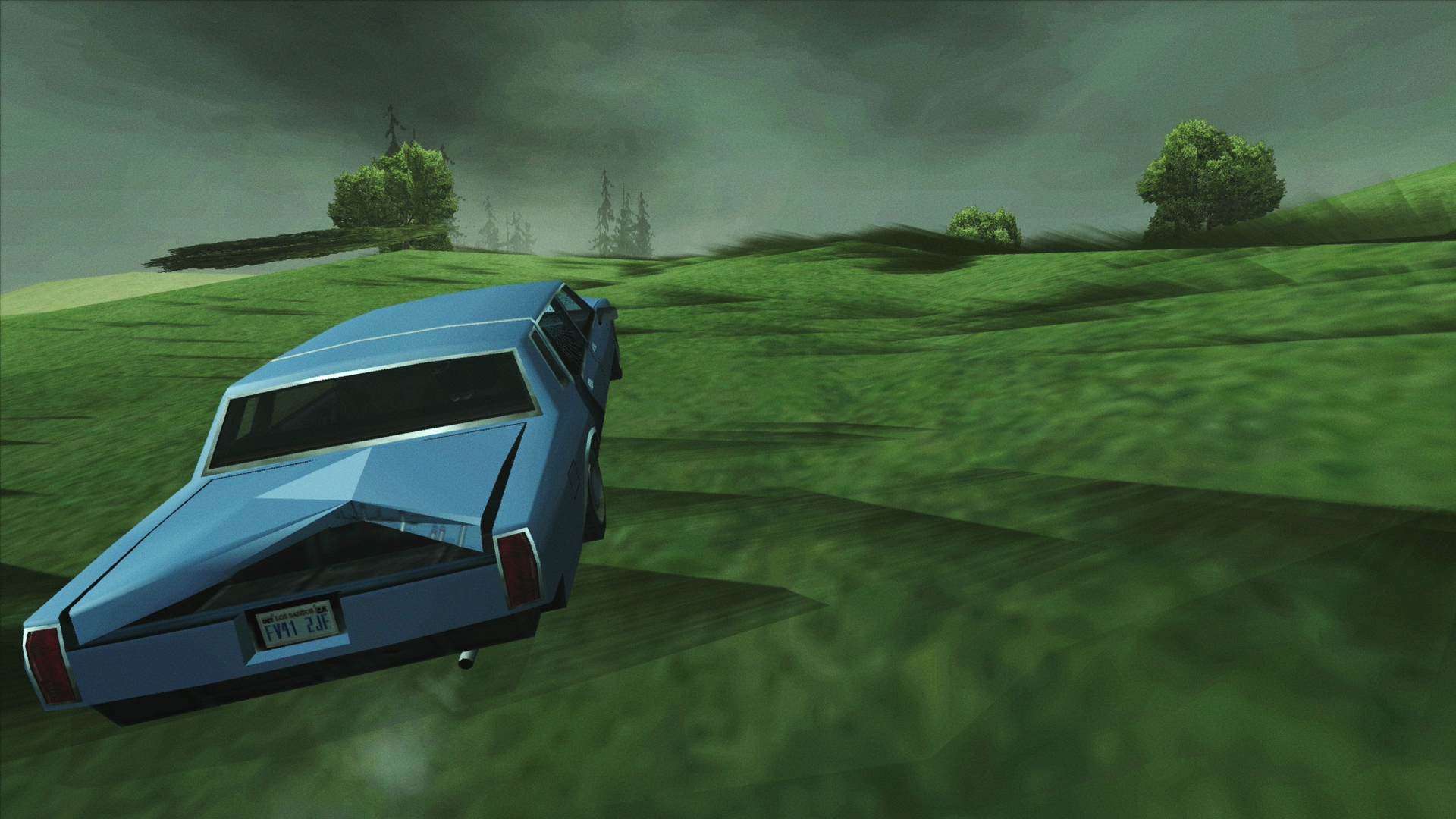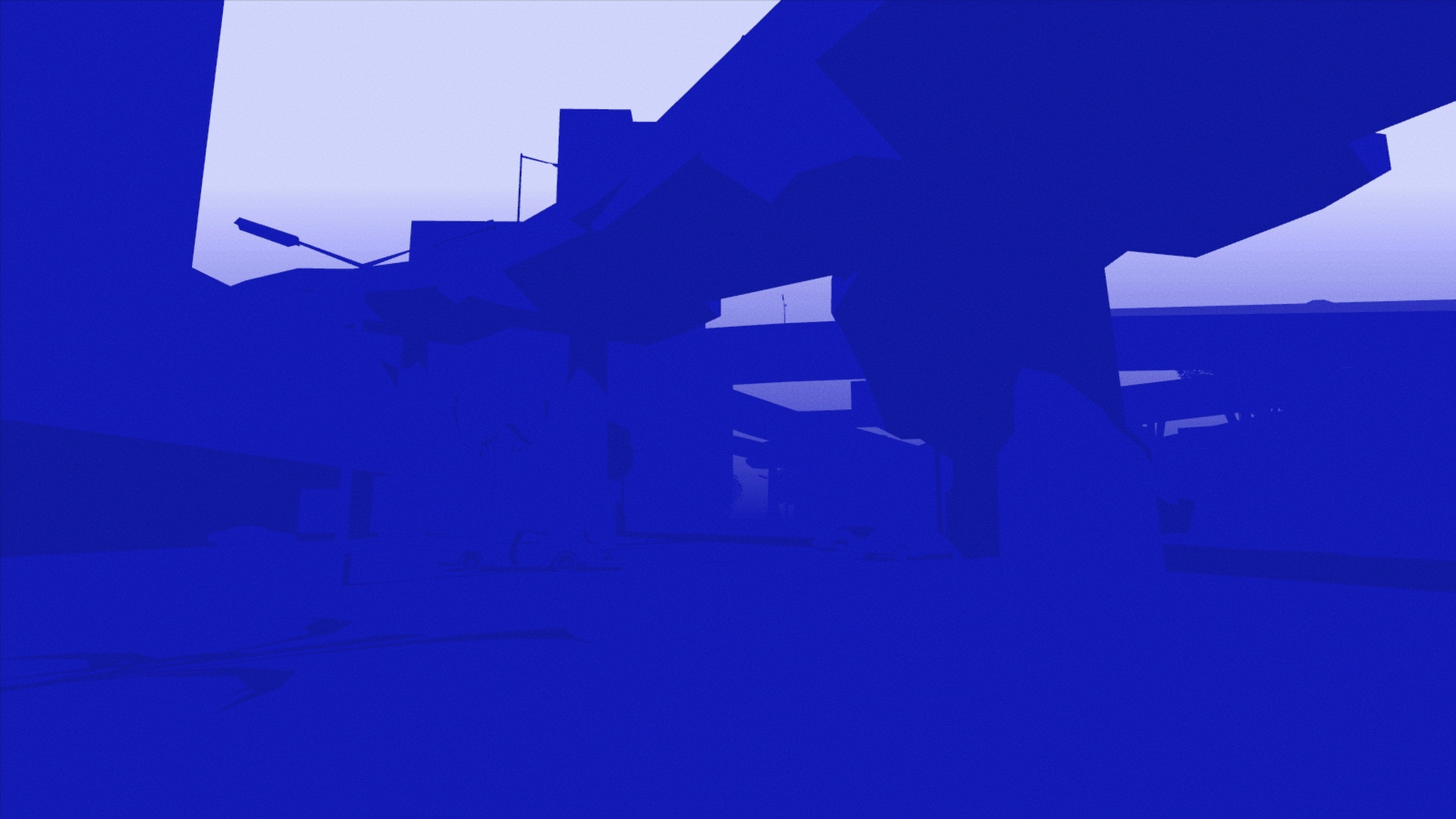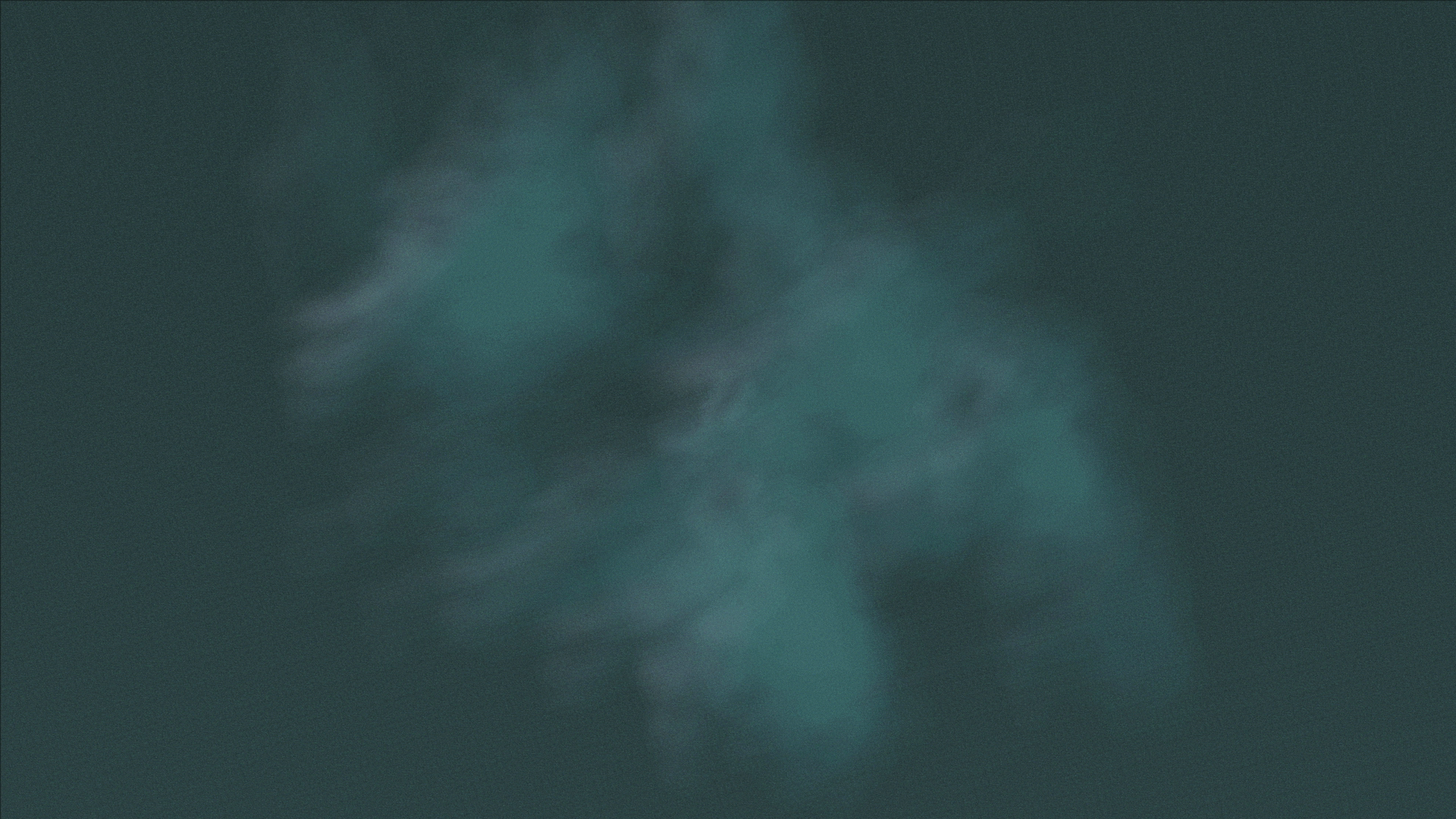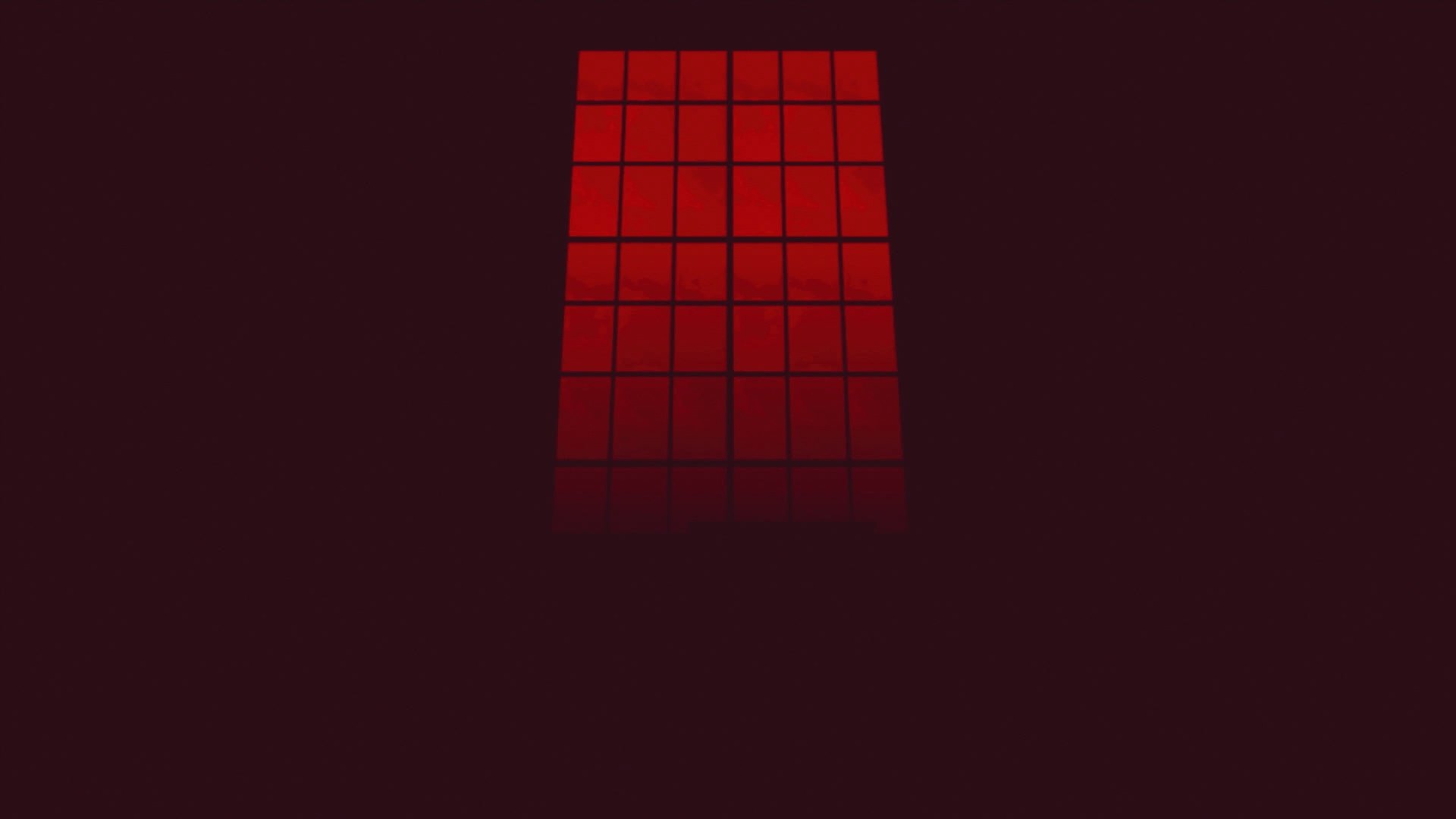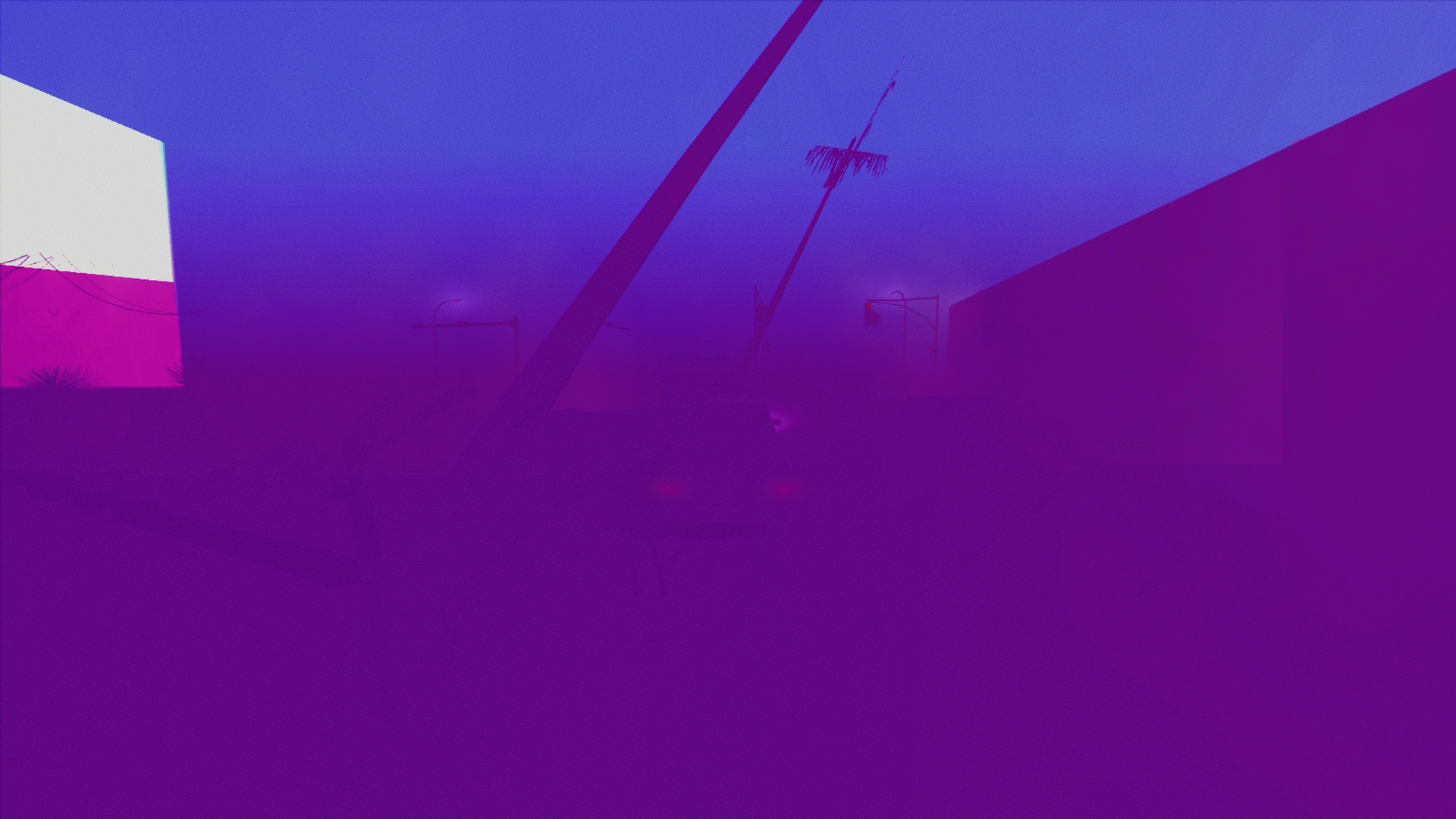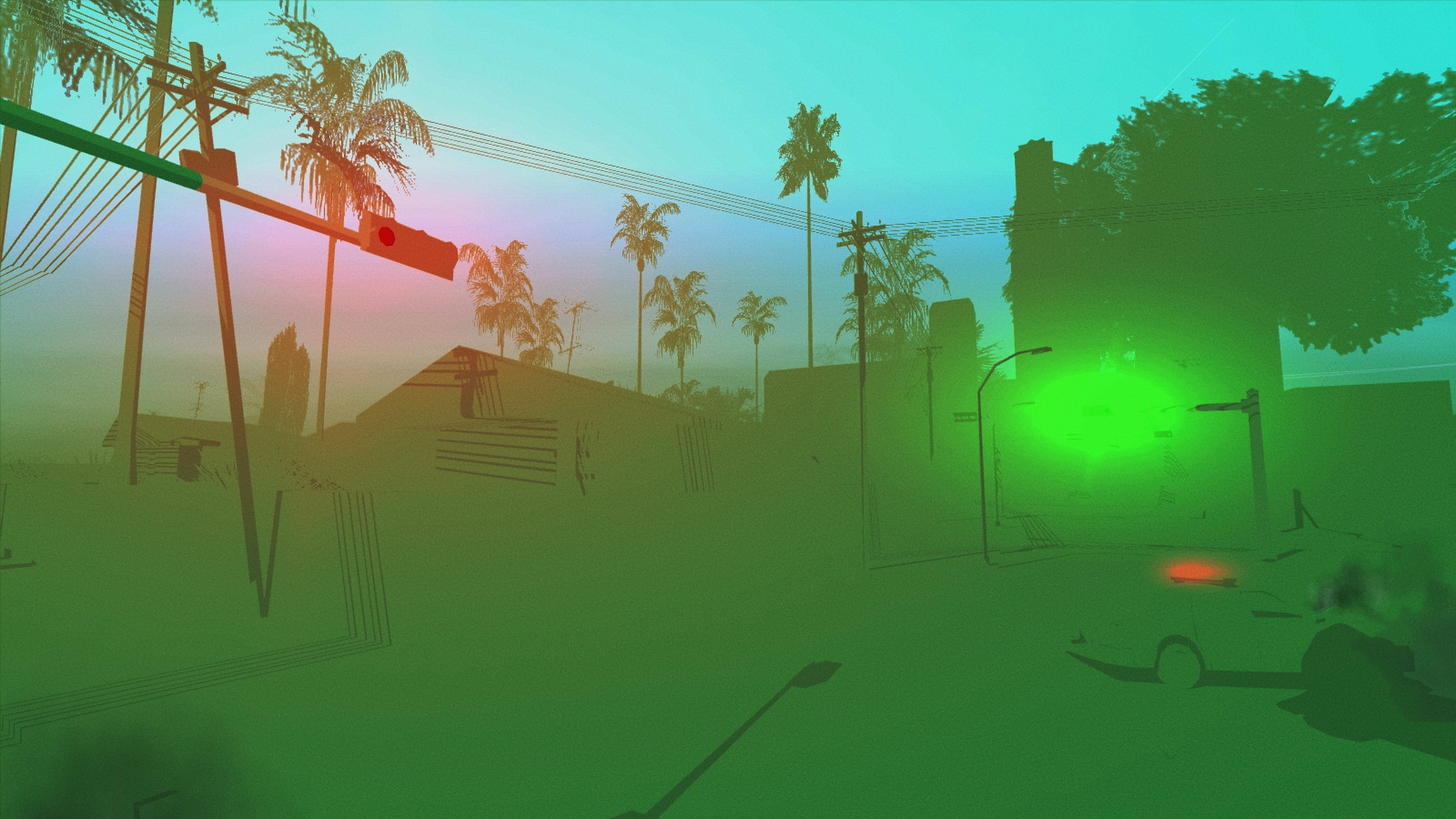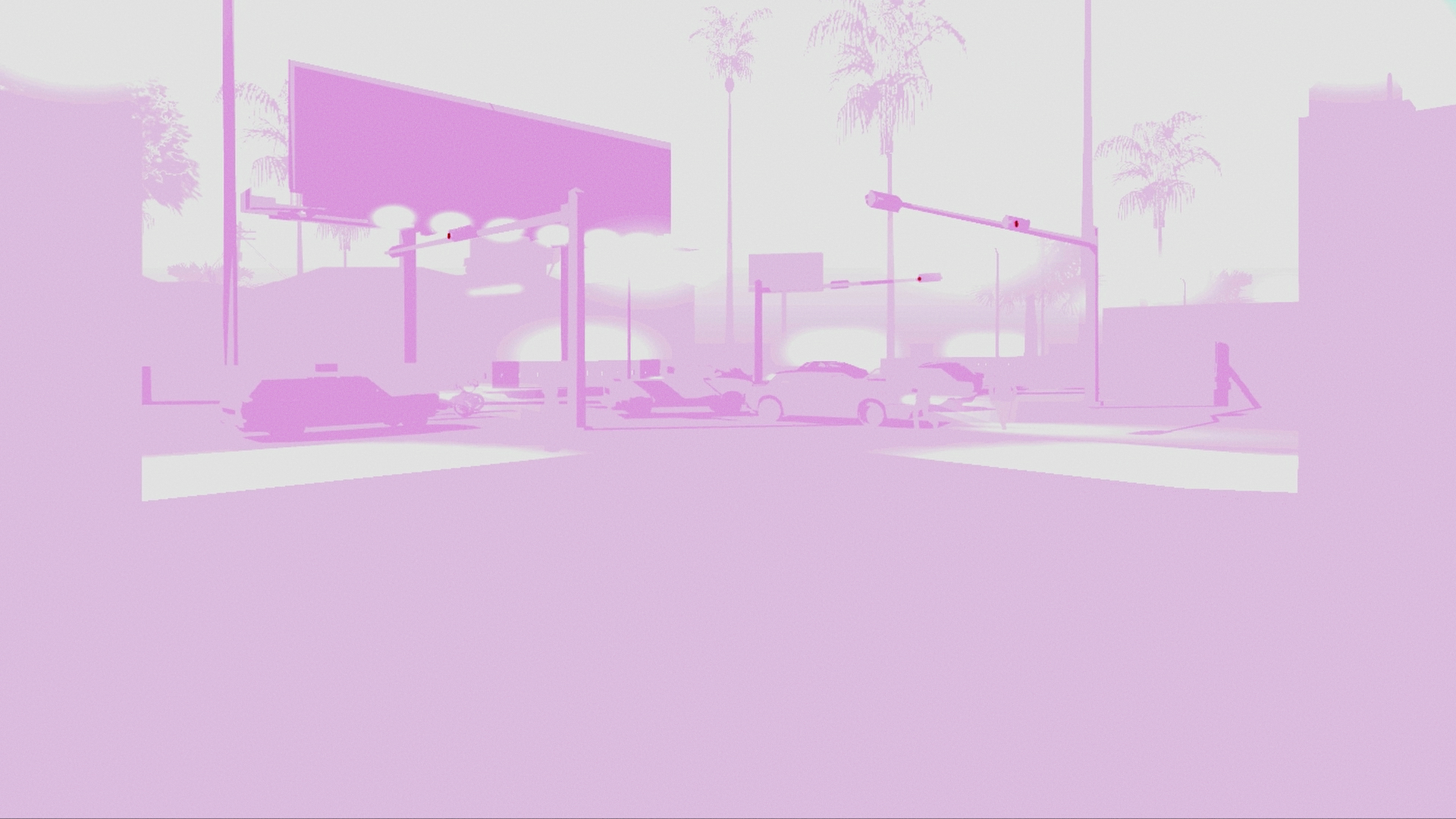Endless Sea
digital video, color, sound, 6’ 59”, 2015 (2023), The Netherlands
Created by Bram Ruiter
Bram Ruiter’s experimental 2015 work Endless Sea was originally shot with/in a modified version of Grand Theft Auto: San Andreas (Rockstar Games, 2004). Yet rather than depicting the crime simulations and violence the game was originally designed for, Ruiter harnesses expanded weather and free camera tools to craft an oneiric aesthetic experience outside gameplay norms. Through prismatic neon haze and perpetual storms visualized with heightened cinematic focus, the 6-minute conceptual work inhabits an ambivalent space between the game’s assumed freedoms and underlying restrictions. As the perspective drifts, glides, pursues unknown figures through the deserted streets, a disquieting sense of surveillance, pursuit and entrapment permeates the mood. Repeated cryptic references to the endless sea itself seems to signal the infinite confines of San Andreas, though whether the despairing urge to break free springs from the player or the lone avatar remains ambiguous. Ultimately Ruiter undermines the promised openness of Rockstar Games’ sandbox architecture by exposing its boundaries through tonal manipulation. Endless Sea is presented on VRAL in a never-seen-before, 2023 remastered edition.
Bram Ruiter is an experimental filmmaker based in Zwolle, the Netherlands, who creates collage-like cinematic morphologies that examine themes of creation, contradictions, labor, and the unfinished or incomplete. Fascinated by marginal objects and obsolescent procedures, his work incorporates non-traditional materials and broken aesthetics. Ruiter’s films have screened internationally at festivals including the Viennale, Karlovy Vary, Pesaro Film Fest, Fantastic Fest Austin, A.Maze Berlin, and the Netherlands Film Festival. Ruiter also teaches filmmaking at ArtEZ University of the Arts, both at graduate and undergraduate level.
Matteo Bittanti: Through your experimental machinima, you manipulate commercial video game environments to convey conceptual ideas through a surreal, metaphorical visual language that is both familiar and unique. How do your gaming-based films relate to your broader artistic practice and ethos? Have they informed or inspired your approach to other mediums and formats? More broadly, what drew you to adopt and subvert the graphic richness yet narratively restrictive spaces of commercial video game productions like Grand Theft Auto for avant-garde filmmaking purposes?
Bram Ruiter: The difference between making a machinima and filming a work in the real world is one of logistics. The games are restrictive, but so is the world we live in. I can’t push my camera through a wall or the floor like I can in a video game. I can float through objects, get up in “people’s” faces without any backlash, I can fly without a plane and dive without holding my breath. It’s what Phil Solomon referred to as the disembodied camera.
It’s, for me, very reminiscent of making music in a DAW (Digital Audio Workstation): all I need is the hardware, the software, my knowledge of the medium and a desire to express myself. I don’t need a crew and I’m not bound to those aforementioned physical constraints, so it’s a very solitary and boundless process. Which can be a nice change of pace from the real-world equivalent. The only difference there is that the DAW software was created for expressive intent while a game is an object of entertainment. Some games have built-in features to free the camera from its fixed relation to the player character, other games need to be modified in order to do anything the base-game didn’t intend.
This modifying and recording can take some time to master, as technology is always in-flux and tries its darndest to make things obsolete as quickly as possible. But, at the end of the day, you’re still working in the same spatial-temporal medium, going through the motions of film production: You’re still wandering through 3D spaces; you’re still converting them to 2D planes; you’re still capturing images and sounds which then, through the process of montage, become a film. It’s just that logistically, it’s a bit different.
Matteo Bittanti: If I understood correctly, Endless Sea belongs to a trilogy developed with/in different episodes of Grand Theft Auto which included Perpetual Spawning and Infinite Skies. Can you share with us what happened to the missing element of the triptych? Is there any hope that this project will eventually see the light?
Bram Ruiter: Endless Sea fell out of me one night and because it featured a bunch of footage in which the disembodied camera floats over the vast generative ocean I decided to call it after what I was seeing. Only later did I realise it was similar to Infinite Skies in both title and texture. I hadn’t intended to make another one nor had I conceived of a trilogy until I randomly came up with a title. Unending Earth would be filmed in San Andreas and utilise the weather mod just like its predecessors (this is why Perpetual Spawning, which was filmed in episode IV, is not part of that trilogy). However, I never got around to make it and I have no idea why.
As for Infinite Skies: the film was made for an assignment during my first and only year at film school. I made it together with Martin Gerrits who was the only classmate excited about the prospect of working on a machinima. For days, we sat side-by-side capturing and modding on two desktop computers in his parents’ attic. We’d come up with sort of a story, something concerning grief and purgatory, heavy adult themes I knew very little about at the time. A typical edgy for the sake of edgy work for a 22-year old, let’s say. At least that’s how I remembered it. However, I found it again after you brought it up and in revisiting I found it’s actually not that bad. So it might see the light of day at some point in the future.
Anyway, I never intended to make a trilogy, but maybe one day I’ll get around to making Unending Earth. Talking about it definitely got me excited again.
Matteo Bittanti In a recent episode of the wonderfully stimulating podcast Celebrating Cinema, you mentioned Brian Eno’s quote about how when we move on from something, its flaws become beautiful features. It seems there could be parallels to deriving new meaning from “haunted”, archaic game platforms and worlds. What poetics emerge, for you, from these obsolete game environments and their visual/temporal instabilities?
Bram Ruiter: It’s a bunch of things. It’s an act of resistance, for instance. To resist technology’s race for profit through forced obsolescence. I had a difficult time trying to explain this in the podcast episode. I think that it’s… I don’t utilise obsolete media for nostalgic reasons, but it’s a way to explore ideas and thoughts about a system of continuous progress. That’s what Eno is getting at: as soon as we bypass a medium’s necessity, we suddenly regard those behaviours particular to the bypassed medium not as limitations but as features. Then comes this deeper aesthetic exploration of those behaviours in the age of obsolescence, which is virtually never-ending.
With each passing year, exploring older media becomes more difficult. The businesses manufacturing the devices we are beholden to don’t care for the past. We try to alleviate this process through virtual plug-ins that emulate those behaviours and that’s nice and all, but rarely is it as easy as slapping an effect on something. I’ve gotten into film emulation over the last few years thanks to Devan Scott (FilmFormally, How Would Lubitsch Do It?, my favourite cinematographer) and I’ve learned that you really have to familiarise yourself with the medium, find those particularities, analyse them, figure out how they move and then try to make a chain of effects that behave in the same or similar way. This deeper understanding opens doors to otherworldly or erratic behaviours you’d never even considered before doing the research and the legwork. Because that’s what it is, you’re trying to make a thing do a thing it wasn’t designed to do. And that’s exciting.
Matteo Bittanti: In the same episode of Celebrating Cinema, you describe having a pivotal early encounter with the experimental films of Stan Brakhage, which Philip Solomon also drew inspiration from. You touched on Solomon’s very personal, emotion-driven filmmaking process, using machinima to work through grief and loss in his seminal In Memoriam series. Do you see parallels to your own more intuitive, identity-rooted approach? Or does Solomon’s raw expressionism contrast your semi-detached, glitch-driven style?
Bram Ruiter: I don’t think I use film in the same way Solomon used it. As someone who creates or expresses you’re always working through something, but for me it’s more about concepts, ideas and thoughts rather than personal experiences. However, personal experience inevitably creeps in. Perpetual Spawning has very little to do with processing personal experience, but I don’t think it’s an impersonal film. I filmed both films at my parents’ dinner table while I was temporarily living with them again due to a financial set-back. I finished Endless Sea in a sort of fugue state then and there. I completed Perpetual Spawning two or three years after filming its initial segments at the same dinner table. Therefore you could say that both films are about being stuck in a place, but that both deal with that theme in different ways. It may not be explicitly about what happened when I made it, but it’s definitely imbued in the works. It’s imbued in the choices I made: the way it moves; the way it looks; the way it sounds. I approached Tom Schley to do the soundtrack for Perpetual Spawning because we had been talking a lot around the time I finished it up. And this autobiographical perspective is exactly that, a perspective. It is one of the ways to read it.
Matteo Bittanti: In the same podcast, you describe formative early moviegoing experiences with Toy Story and Jurassic Park, which opened your eyes to the spectacle and world building of blockbuster cinema. Looking at your experimental machinima films today, do you see any continuity with these childhood touchstones around fantasy, imagination and what film historian Tom Gunning called the “cinema of attractions”?
Bram Ruiter: Trying to find a way to express what I perceive, all those things I have in my head, is at the core of everything I do, I think. Now, we can draw a straight line from Endless Sea to Spielberg, but it’d be a sweatily drawn line with a lot of curves and back-ups.
What I do respond to is Méliès’ quoted by Gunning: “As for the scenario, the ‘fable,’ or ‘tale,’ I only consider it at the end.” It doesn’t always work that way, but reading that just now (thank you, Matteo) made me realise this is how I generally make films. I have a bunch of, what Méliès calls Tricks and Stage Effects, and then I try to connect the dots one way or another. Mine are usually existing materials that contain ideas I feel like exploring and previously filmed material. What’s important to know about my process is that I film. I film a lot, often without a plan or goal. I’ll probably come back to this intuitive creation further in this interview.
Anyway, editing is wonderful for this. You have two images and you put them on a timeline, one following the other. The cut automatically connects whatever is conjoined, no matter how disparate it may seem. This way of cutting is something I’ve been exploring with my non-machinima films such as A Weave of Light or Here & Elsewhere. Both are built on top of some existing elements, not for the sake of explaining or informing, but to have some sort of organising principle from which I can navigate and to which I can return. For A Weave of Light the backdrop were the interviews based on the exposed but undeveloped roll of film, for Here & Elsewhere the backdrop consisted of a poem by Jorge-Luis Borges in conjunction with a bunch of footage I had already filmed. The process of assembling these elements gives rise to new ideas, which then shapes the film as you’re making it.
This conjoining of disparate elements has always been a part of cinema, of course. Filmmakers like Jean-Luc Godard, Artavazd Peleshyan and, more recently, Isiah Medina and Laida Lertxundi have done a lot of great work in the field of editing. Beacons of light, all of them.
Matteo Bittanti: While preparing a course on utopian and dystopian visions conceived by contemporary British and American critical thinkers, including Peter Frase, Nick Srnicek, Alex Williams, Aaron Bastani, and James Bridle, I encountered Medina’s Inventing the Future. I was profoundly impressed by his skill in transforming a non-fiction book, bordering on a manifesto, into a potent visual and auditory meditation. Such an approach is a rarity in the realm of machinima. Going back to Celebrating Cinema, you vividly recall seeing Steven Spielberg’s name in the credits of The Lost World as a child and initially believing films were made in real-time. How has carrying this sense of wonder and mystery around the filmmaking process shaped your desire to tinker under the hood of game engines and “take apart” their constructed worlds?
Bram Ruiter: I’ve spent plenty of nights or afternoons taking turns with a friend playing one of the Grand Theft Auto games. At a certain point, out of sheer boredom, you start coming up with rules or tasks. Games that are not in-game, but utilise the objects in the game. Like, steal a tank or fighter jet and try to stay alive as long as possible. These vehicles are only available in heavily guarded areas, so the moment you jump a fence, you get the entire army after you. This goal is not a built-in game mode, but something we came up with ourselves to pass the time. During play we’d stumble upon exploits in the system. We’d tell our friends about it. The next day, we’d try again. Sooner or later, scouring the internet or hanging out with friends or by just carousing the game world, I’d stumble upon something that would make me go ‘hmmm, question mark’. And then I’d act on that impulse and find myself doing something the game world allowed for but the developer did not intend. It comes with the territory.
Matteo Bittanti: The immersive environments and sandbox gameplay of open-world games, such as Grand Theft Auto, appear to have significantly stimulated your imagination, even as an adult experimental filmmaker. What unique qualities do these virtual spaces possess that set them apart from the blockbuster movie worlds that captivated you in your earlier years?
Bram Ruiter: A film invites thought. It’s a linear static object that you relate to differently each time you watch it. Your interaction with a film is always virtual, never physical. It lives in the mind, it lives on paper. The only way you can apply the idea of interaction to a film is by making a film as a reaction/elaboration. Or, perhaps, by re-editing the existing footage into something new. But that’s not entirely the same as a video game, which necessitates interaction from the get go. This interaction then invites the possibility of change.
Matteo Bittanti: Do you see room for inspiration from today’s CGI-driven franchises as well?
Bram Ruiter: Oh, for sure! I mean, as works of fiction they are often tremendously boring. They are vehicles for dispensing information and conveying violence and they seem barely curious about themselves or their place in the world. However, I’m a massive fan of janky CGI and I gladly watch these blockbusters to see them fall apart, which they usually do. I watched the new Aquaman the other day and I was fascinated by how noticeably disparate the reshoots were from the rest of the film. It’s bookended by these green screened sequences clearly filmed some time after the initial production wrapped. The seams are showing and fraying and that’s when the picture comes alive for me. Beautiful stuff, even when most of it is mind-numbingly boring. Something like Attack of the Clones, Resident Evil: Retribution or Speed Racer are perhaps better examples of movies which find a unique expressiveness in janky CGI. As YouTuber ThorHighHeels, king of jank-embracement, once put it: “the artifice in artisticness is the artiness laid bare and I see no reason as to why hiding the art part of the art would ever make any sense. Because that’s what it is, stupid!” I should learn Blender at one point. Or befriend a VFX artist.
Matteo Bittanti: In Endless Sea and Perpetual Spawning, you experiment with such themes as the creative process and the narrative structure. These films are built upon ideas of entrapment and isolation, symbolized by endless oceans and glitching NPCs. How do you believe these films critique the illusion of freedom in open-world games and reflect on the psychological, social, and creative constraints within these virtual environments? Additionally, how do these elements contribute to the films’ atmosphere of anxiety and isolation? I’m curious about your perspective on how gaming liberates or limits users psychologically, socially or creatively, and whether that informs the atmosphere of anxiety and isolation being so vividly rendered on screen.
Bram Ruiter: I’m gonna take this opportunity to just roam in some thoughts on video games. Let’s hope I make a good point at the end!
The other day I finished Stray. It’s the game where you play as a cat in a post-apocalyptic world inhabited by robots. I needed something nice and relatively short to play over Christmas and stray was perfect. However, I was also confronted with something that has always bothers me a bit. While I loved traversing the little villages, talking to robots and connecting dots, looking at the beautifully crafted environments, scaling rooftops, I did not care for the, for lack of a better word, cinematic gameplay. There definitely are fun bits outside of the villages that contextualise , once I found myself running through a tunnel avoiding these creatures, rapidly tapping a button to shake them off, I felt myself disengaging. It felt like a half-hearted attempt at tacking on cinematic action for the sake of making the game appeal to a wider audience. Increase sales!
Now, I need to say that there are plenty of games out there that have no interest in trying to “transcend” their own medium by invoking cinema (or literature, for that matter, but that’s a whole different story). I play Mario or Kirby games because I want to engage with its systems. I play Fallout or Red Dead Redemption because I want to traverse this landscape and stumble my way through a collection of short stories. I don’t play Red Dead Redemption for the big spectacle turret section in the final act, let’s say. It’s a weird practice to deliver these spectacles that mechanically have very little to do with what preceded.
Video games are sometimes quite eager to “transcend” their medium by invoking the cinematic. As if they’re ashamed of being a game. It’s a weird practice. I don’t mind cutscenes, mind you. I don’t mind it when games have a story. I cried at the end of Journey like everyone else, I really like Hideo Kojima, especially when he’s at his most alienating. I need the media to explore the ideas it brings up and not just regurgitate tropes for the sake of accessibility and comfort. And so often I feel as if either the story or the cinematic gameplay is tacked on top of it because the game has to do that now. So, to come back to your question, finally: the sense of agency only reads as false when its intentions are stemming from some exterior motivator. I’ve been a lonesome cowboy and sure, I’ve been in some pretty high profile gunfights, but mowing down hundreds of faceless antagonists from the back of a turret for the sake of Going Big is not my idea of a fitting ending to my career as a lonesome cowboy.
Matteo Bittanti: You mention being intrigued by the emptiness of the Grand Theft Auto game world that Phil Solomon highlighted, while also appreciating the potential for beauty in the vibrant colors against the violence. Above all, the nonlinear, fragmented narrative echoes the logic of dreams where one moves forward without clear progression. What informed this non-traditional storytelling structure? Were you inspired by any particular films or filmmakers in this regard, besides Solomon?
Bram Ruiter: I wouldn’t call it a story, not even in a non-traditional sense. You can read a narrative in it, perhaps, but for me it’s rather an expression of thoughts, ideas and feelings purely through images and montage. A story feels too fully formed. I’d rather provide a concept, food for thought, something non-hermetically sealed.
It’s a typical rite of passage for avant-garde enthusiasts, but the discovery of Stan Brakhage’s films was very formative in that regard, as were the films of Maya Deren. I must’ve been 17 when Brakhage taught me about texture and speed, and Deren taught me about the oneiric quality of film. Then, later on, I would come across the works of Apichatpong Weerasethakul and Peter Tscherkassky. Besides Syndromes and a Century, I’ve always gravitated more towards Weerasethakul’s shorts and installation work. His conceptual explorations of space and memory work best in short form for me. Shorts invite revisiting, looping even. The relative ease to encounter it again and again opens the work up for a deeper contemplation, in my experience. But maybe I have no attention span, haha.
Tscherkassky’s films, on the other hand, are loud, both visually and aurally. They’re also built from existing materials and embrace projection mistakes as its modus operandi. It takes me back to listening to the Onkyo-masterpiece “Good Morning Good Night” by Sachiko M, Otomo Yoshihide and Toshimaru Nakamura in one sitting, my ears ringing hours after finishing it. Or being at a My Bloody Valentine concert and feeling the whole venue shake under the extended bridge of “You Made Me Realise”, which consists of a continuous layering of noise. When people speak of spectacle that’s what I think of, a physical experience of art. Texture is also something physical. I can only describe it in the context of touch, the way it feels between my fingers, even when it is something as film grain. This brings me back to Solomon, whose celluloid work is an expression of thought and feeling through thick photochemical texturing.
Matteo Bittanti: In the aforementioned conversation (Celebrating Cinema), you describe discovering the fascinating “weather mod” for Grand Theft Auto that adds hundreds of new weather variations, from which you drew inspiration for the vivid colors and textures in Endless Sea. How did you go about capturing, cataloging and ultimately selecting from this expansive palette to craft the film’s surreal, oneiric aesthetic? Were particular weather effects especially conducive to the mood you hoped to evoke?
Bram Ruiter: I never catalogued anything. I mean, I sure tried to, but there are too many variables at play. Weather state 3495 would be entirely different at noon in this area than at midnight in that area. The map is vast and the weather states seemingly endless. So the process came down to: scroll until I was intrigued by an effect, determine my composition, then hit record and hope the weather state wouldn’t crash the game. That was most of it, really. You will not believe how often I had to sit through those unskippable loading screens because of a crash.
Matteo Bittanti: Oh, I feel you. Sounds like the very definition of purgatory. This is one of these cases when theme and process converge. Both Endless Sea and Perpetual Spawning leverage modifications of the Grand Theft Auto open-world game engine to alter and capture the environment, taking advantage of expanded weather effects, free camera tools, and software glitches. Could you think of an equivalent of modding for non-game based filmmaking? Does Stan Brakhage and Phil Solomon chemical/alchemical practice with celluloid qualify as modding sui generis? If so, is it possible to discern a direct lineage between experimental cinema and machinima?
Bram Ruiter: Oh, definitely! I think you’re right on the money here. The modding practise and celluloid practise are in many ways very similar. They both involve altering a base object through unconventional (or unintended) means. I’d also like to add that they both come with a very dedicated community eager to share their findings. And it’s a very human thing to desire, obviously. To want to be part of a community. To want to improve your understanding of the world by applying yourself to an interest. If the internet has taught us anything it’s that even when the interest seems incredibly obscure, you’ll probably find like minded folks knee-deep into it already. I have a friend who joined a garden dedicated to growing dahlias, for instance. She’s gaining very specific knowledge alien to most of us who aren’t into botany. I love that type of specificity and love getting lost in it myself.
Matteo Bittanti I was especially fascinated by Endless Sea’s time lapse of shifting skies, which represents the passage of time despite nature’s persistence. What were you expressing with this evocative montage both visually and philosophically?
Bram Ruiter: Well, I think you pretty much got it. I also think the speed of certain on-screen elements set against the idea of being stuck creates a necessary tension. I don’t know, it’s difficult to talk about certain specificities regarding this film because I started mixing colours and painting without much of a plan. And then, once the whole thing came together, I slowly realised what I was making or saying. Mary Helena Clark, another beacon of light for me, described it to me as a process of working intuitively and then analytically, ad infinitum. So, you paint, you take a step back, you regard and think, and then you take a step forward to paint again. Sometimes you paint for a long time before you take a step back, other times you take a step back after every brushstroke.
Matteo Bittanti: Eight years after its original release, you have remastered Endless Sea. What did the process of revisiting and upgrading this machinima entail technically and creatively? Were you striving to enhance particular qualities or explore new directions? How has your perspective shifted in this time frame? Are you planning to remaster Perpetual Spawning as well? What does a “remaster” entail, specifically?
Bram Ruiter: The remaster came about last year. Collectif Jeune Cinema wanted to put Endless Sea in their distribution catalogue and all I could offer them was a highly compressed 720p file. Luckily, I still had the original footage and soundtrack. At first, I faithfully rebuilt the film in DaVinci Resolve and in doing so, I started to reconsider some previously made choices. The first and foremost was the aspect ratio: the original was in cinemascope not because I thought it would look cool, but because I needed to crop out some UI elements. While rebuilding I noticed the compositions were more balanced in regular widescreen because, well, I originally filmed them that way. The UI interference was so minimal, and could be solved with a zoom, that I decided to stick to the original aspect ratio.
The second reconsideration was a structural one. It was like reading an old poem: it’s all there and the idea is good, but I can now clearly see that shuffling around some lines and losing some others would make it flow a lot better. So, that’s what I did. For Infinite Skies I cut some things, shortened others, but the continuity of the film is the same as it was back in 2011. Perpetual Spawning doesn’t need a remaster because, by 2018, I was wise enough to render high resolution versions of everything I make. Plus, I still 100% stand behind all my choices there.
Matteo Bittanti: In Endless Sea, you embed symbolic meaning into ordinary objects and environments from Grand Theft Auto through considered repetition and context. For instance, birds taking flight over the city seem to represent an elusive desire for freedom, while the idling car engine in the opening shot signifies a kind of motionless stasis. Given the limited visual “vocabulary” available within the game’s software, how do you strategically appropriate certain assets as symbolic signifiers?
Bram Ruiter: I like your metaphorical reading, here. I don’t think I ever considered the car more than an in-tact figurative object against the trees that sway unrealistically in the wind. I wasn’t very concerned with metaphor while making it. It was colour and texture that did it for me.
Matteo Bittanti: As a media scholar, I am obviously biased and I have to ask a question about “media specificity”, as pedantic as it may sound: What drew you to try conveying conceptual ideas around confinement and escape through the highly restricted assets of an off-the-shelf video game rather than through more abstract experimental filmmaking methods or recorded footage?
Bram Ruiter: As I mentioned before, I was forced to live with my parents again out of financial necessity. If that’d happen to me now, I would probably take my camera and go outside, but back then I did not feel any desire to film my immediate surroundings. And whenever I went outside, I would travel from the tiny village I grew up in back to the city I had to leave and would soon move back to. Outside, I was doing commissioned work — online content, commercial in nature — and, at the time, I thought of myself more as a documentarist so, well, I pursued that. Looking back, I believe I was attracted to machinima filmmaking because it was something I could do without any resources, but also because, up until that point, the only artistically satisfying experimental film I had made was a machinima. I must’ve gone back to that well and clearly it wasn’t empty yet.
Matteo Bittanti: The sound design plays a crucial role in creating the surreal ambiance. The score is minimalistic yet evocative, haunting and dissonant, reflecting the film’s contemplative nature. Can you provide some context about the process of creating the machinima’s soundtrack?
Bram Ruiter: Hmm, it’s been a while. From what I gathered during my remastering process, the basis for the soundscape was made using PaulXStretch. This is a free application which can stretch out sounds without changing their pitch. So, you could put a two second sound through it and have a 12-minute soundscape come out the other end. This is how people made those Justin Bieber but ambient pieces back in the early 2010s. It’s a good device to make some pads. And that’s exactly what I did: I stretched out a sound and then I pitched it up and down and crossfaded the different pitches until this rolled out of it. Once again a very intuitive process. However, I can not for the life of me remember what the unedited sound was or where I got it from.
Endless Sea
digital video (H.D., 1.77:1), , color, sound, 6’ 59”, 2015 (2023), The Netherlands
Created by Bram Ruiter, 2015 (2023)
Courtesy of Bram Ruiter, 2024
Made with Grand Theft Auto: San Andreas (Rockstar Games, 2004)


